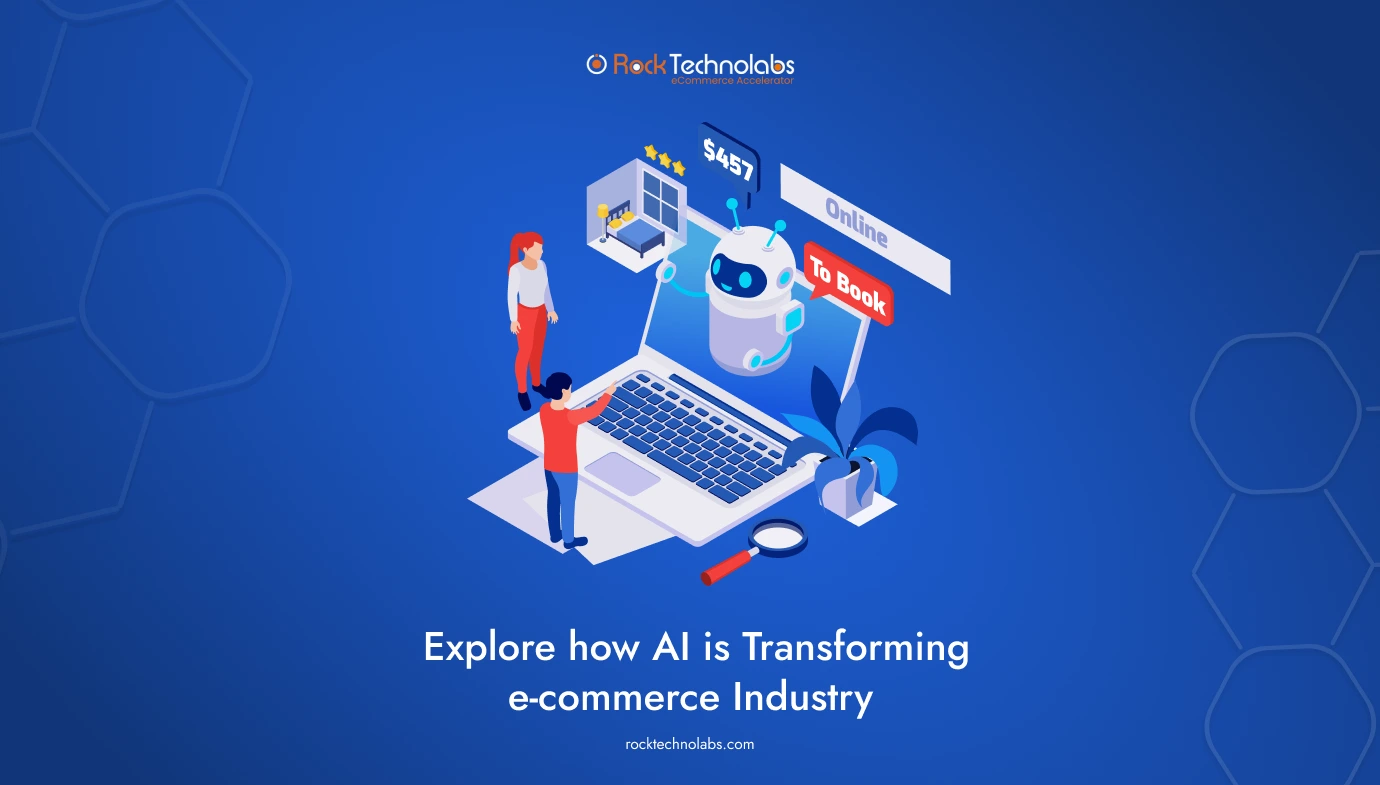Explore how AI is Transforming e-commerce Industry

Look, AI isn’t just some futuristic buzzword anymore; it’s already running the show behind the scenes for e-commerce stores nowadays. Seriously, the second your customers click onto a store’s homepage, there’s a whole digital brain picking apart what they might want, how they might act, and which things they’re most likely to buy.
Even as per the recent data, eCommerce retailers generate between 10% to 30% of their revenue from suggestive selling in which agentic commerce engines can help a lot.
Stuff that used to take an army of marketing nerds and data geeks? Now it’s happening in real time, all automated and, honestly, kinda shocking with how spot-on it can be. It’s not just about better recommendations or those sneaky price changes; there’s even virtual try-ons now. Shopping online’s getting faster, weirdly personal, and, yeah, almost more “human” in a way (which is hilarious, considering it’s all computer code).
And via this blog, we are going to explain to you why as an e-commerce merchant, you should opt for it, and how it can benefit your e-commerce business.
Types Of AI Technologies For E-commerce
1. Machine Learning (ML)
Machine learning is a really common type of AI in online shopping. It lets sites look at tons of customer info, like what they’ve looked at, what they’ve bought, and how they click around to spot trends and guess what they might do next. Machine learning basically helps in suggesting new things/products to the customers in ecommerce stores in addition to changing prices based on demand, and splitting customers into groups and the best thing about these systems is that they get smarter over time, so they get better at giving your customers a personal shopping experience and helping the store sell more.
2. Natural Language Processing (NLP)
Natural language processing helps online stores understand what people say and write. It powers chatbots and helpers, so your customers get instant help or find your way around faster. It’s also behind voice search, which makes it easy to shop if your customer is using a smart speaker or phone for any e-commerce platform. Plus, it can read customer reviews to see how people feel, so stores can fix problems and make people happier.
3. Recommendation Systems
Recommendation systems are AI-powered engines that utilize a huge volume of user data so that it can suggest products that fit under different customers’ preferences which is done by leveraging like browsing history, past purchases, and similar shoppers’ data to come to a conclusion what this customer might want as the next product to provide suggestions that customers might really be interested in. Thus by seeing such products customers want to spend more cash through extra purchases in the e-commerce store.
4. Generative AI
Generative AI is the branch of artificial intelligence that focuses most on creating new content including text, images, and videos, based on the data they have been trained on. In e-commerce it is used to automate the content creation process (write product descriptions, ads, social media posts, and marketing emails), for high-quality product images, and automating manual wordloads. By doing all this it helps to do the product listing faster, maintaining consistency in quality and tone of work while minimizing human errors that can result in adverse consequences for sales.
Benefits And Impacts Of AI In E-commerce
1. Nailing the Right Price (So Customers Don’t Overpay… or Undercharge)
You know those sneaky price drops or hikes that seem to pop up at just the right (or wrong) time? That’s AI. These smart tools are constantly snooping around, checking out what the competition’s charging, how many people are buying, what’s in stock, and whether it’s Black Friday or just a boring Tuesday. AI basically plays chess with pricing, adjusting whenever required, so e-commerce stores can generate more cash without scaring you off. Manual pricing? That’s like riding a tricycle in a Formula 1 race.
2. Search That Doesn’t Work, Customers Feel Like Screaming
Ever type something into a site’s search bar and get results that make you question if this store really sells products as you are unable to find what you are looking for? AI fixes that. Now, whether you type in chicken scratch, use slang, or upload a pic of that shirt you saw on TikTok, the site actually gets what you want. It’s like Google’s smarter cousin, understanding typos, weird phrasings, all of it. You spend less time rage-scrolling and more time finding what you actually want to buy. Win-win for merchants who apply such strategies.
3. Personalization That’s a Little Bit Creepy (But Mostly Awesome)
Look, we all know brands are watching, and they need to, even your competitor is doing the same by stalking every click of their customers that they find useful. Now with AI, stores remember what was browsed, what was bought, what customers almost bought at 2 a.m. and then they use it to show stuff their buyers actually want. Stats don’t lie: most people (like, 7 out of 10) expect brands to treat them like VIPs with personalized deals. And yeah, the b2b, and b2c ecommerce platform, and companies love it too, because at the end the customers will end up spending more.
4. Recommendations That Don’t Suck
You know how Netflix somehow knows you’ll binge that weird documentary? E-commerce stores are doing the same thing. AI looks at customers’ habits, past buys, and even age/gender/whatever else they’ve shared, then throws out suggestions customers might actually care about. It’s not just random stuff either, it keeps getting smarter as the seller’s shop. Sometimes it’s so spot-on, it feels like witchcraft. Or just really, really good code.
5. Cross-Selling and Upselling Like a Pro
If you’ve ever added something to your cart and immediately got hit with “You might also like…” and thought, “Dang, that’s actually useful”, yeah, that’s AI again. It’s not just guessing, it’s looking at what people like you, I mean to customers who tend to bundle together, or what upgrades are actually worth it. Maybe too convenient, but hey, if you’re gonna buy a laptop, you might as well get the mouse, right? It’s all about bumping up that cart total without making customers feel like they should leave the e-commerce stores.
6. Customer Support That Doesn’t Make Them Wait ‘Til They Die
Those little chat bubbles popping up in the corner of every site? Bots. But not the boring kind. Some are actually decent now. Ask where your order is, or how to return those shoes you regret buying—instant answers, day or night. Sure, they’re not perfect, but they’re learning every day. Plus, with such features, customers don’t have to listen, please wait over the call we are connecting, ever again, which is honestly a convenience.
7. Inventory Tricks
Behind the scenes, AI is running the show in the warehouse too for e-commerce stores now. It predicts what’s gonna sell out, what’s gonna flop, and even helps move stuff around with robots. No more “sorry, out of stock” heartbreaks (well, less often anyway). Thus, this trick helps in saving money, keeping enough inventory at the right time, and customers ultimately get what they want faster. Everybody wins, except maybe the old-school warehouse manager who misses doing inventory on paper.
AI Use Cases In E-commerce
Personalized Product Recommendation
We’re sure you have already seen this. Ever browsed your competitor’s site and suddenly it’s reading your mind, showing you that hoodie you didn’t know you needed? That’s AI crunching the data, what you clicked, bought, or even just glanced at and served up what you’re most likely to buy next. It’s like having a personal shopper who never sleeps and never judges your taste in socks.
Customer Segmentation
Then there’s customer segmentation. Instead of just lumping customers in with ‘everyone who’s bought shoes,’ AI constantly updates what group your customers are in based on your latest moves. Maybe they’re suddenly into kitchen gadgets. Boom, now they’re getting emails about air fryers. It’s way more dynamic than old-school marketing lists.
Sales And Demand Forecasting
Sales and demand forecasting is like having a fortune teller, and a very useful feature that helps to increase sales. AI looks at all the data, like past sales, market trends, even weird real-time stuff and guesses what you’ll need in stock next. Not perfect, but way better than just guessing like those old days, 2010 inventory managers.
Agentic Commerce & Checkout
Now, agentic commerce and agentic checkout… this is where it gets out of the box. Agentic AI isn’t just helping, it’s making decisions and taking action. So instead of just suggesting a discount, it’ll actually change prices or reorder stock automatically, based on what’s happening right now. Checkout gets smarter too, think loyalty rewards applied without customers even asking, or skipping steps if there is a repeat customer. Basically, it’s trying to make shopping so easy that buyers don’t even think.
So yeah, AI in ecommerce isn’t just tech hype, it’s everywhere, quietly making your buyers’ online shopping experience amazingly efficient.
Conclusion
So, bottom line? You have to accept that now AI is the secret sauce making online stores actually work these days. It basically guesses what buyers want, figures out how to sell it to them, and then makes sure it lands on their doorstep without a hitch. The tech isn’t just helping out anymore, it’s now involved from start to end process. Chatbots that don’t sound like robots, warehouses running smoother than ever, checkouts that feel like magic, all thanks to AI flexing its muscles in the background.







